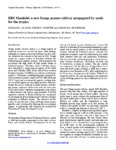Use este identificador para citar ou linkar para este item:
http://www.alice.cnptia.embrapa.br/alice/handle/doc/970780Registro completo de metadados
| Campo DC | Valor | Idioma |
|---|---|---|
| dc.contributor.author | ASSIS, G. M. L. de | pt_BR |
| dc.contributor.author | VALENTIM, J. F. | pt_BR |
| dc.contributor.author | ANDRADE, C. M. S. de | pt_BR |
| dc.date.accessioned | 2013-11-07T11:11:11Z | pt_BR |
| dc.date.available | 2013-11-07T11:11:11Z | pt_BR |
| dc.date.created | 2013-11-07 | pt_BR |
| dc.date.issued | 2013 | pt_BR |
| dc.identifier.citation | Tropical Grasslands-Forrajes Tropicales, Cali, v. 1, n. 1, p. 39-41, 2013. | pt_BR |
| dc.identifier.uri | http://www.alice.cnptia.embrapa.br/alice/handle/doc/970780 | pt_BR |
| dc.description | Forage peanut (Arachis pintoi) is a forage legume of relatively recent use in beef and dairy cattle feeding. Although it is native exclusively to Brazil, the first culti-var, Amarillo, was released in Australia in 1987. Forage peanut has a great number of favorable attributes for establishing grass-legume mixtures, which guarantee the persistence and high yields of high quality forage in cultivated pastures. Therefore, studies with this species have intensified in many tropical regions of the world (Assis and Valentim 2009). In the state of Acre, western Brazilian Amazon, 137,000 ha are cultivated with forage peanut, cv. Belmonte, benefiting thousands of producers, with an annual economic impact of USD 46M (Embrapa 2012). Social and environmental impacts resulting from the use of this legume are also highly positive. However, despite the success achieved in mixed pastures with for-age peanut, expansion of the area sown has been rela-tively slow because vegetative propagation using stolons is labor-intensive and requires large quantities of limited vegetative material. In Brazil, Embrapa has coordinated the development of new forage peanut cultivars and their evaluation in different biomes. The objective of this work is to present a new cultivar of forage peanut propa-gated by seeds, developed by Embrapa for use in tropical regions, in partnership with Unipasto (Association for Promotion of Forage Breeding Research). | pt_BR |
| dc.language.iso | eng | eng |
| dc.rights | openAccess | eng |
| dc.subject | Forage peanut | pt_BR |
| dc.subject | Cacahuetes forrajeros | pt_BR |
| dc.subject | Arachis pintoi cv Mandobi | pt_BR |
| dc.subject | BRS Mandobi | pt_BR |
| dc.subject | Acre | pt_BR |
| dc.subject | Amazônia Ocidental | pt_BR |
| dc.subject | Western Amazon | pt_BR |
| dc.subject | Amazonia Occidental | pt_BR |
| dc.subject | Leguminosas forrajeras | pt_BR |
| dc.subject | Nueva variedad | pt_BR |
| dc.subject | Nutrición animal | pt_BR |
| dc.title | BRS Mandobi: a new forage peanut cultivar propagated by seeds for the tropics. | pt_BR |
| dc.type | Artigo de periódico | pt_BR |
| dc.date.updated | 2017-06-26T11:11:11Z | pt_BR |
| dc.subject.thesagro | Nutrição animal | pt_BR |
| dc.subject.thesagro | Leguminosa forrageira | pt_BR |
| dc.subject.thesagro | Variedade | pt_BR |
| dc.subject.nalthesaurus | Animal nutrition | pt_BR |
| dc.subject.nalthesaurus | Forage legumes | pt_BR |
| dc.subject.nalthesaurus | Arachis pintoi | pt_BR |
| dc.subject.nalthesaurus | New variety | pt_BR |
| dc.description.notes | Publicado também nos Anais do 22º INTERNATIONAL GRASSLAND CONGRESS, Sidney, 2013. | pt_BR |
| riaa.ainfo.id | 970780 | pt_BR |
| riaa.ainfo.lastupdate | 2017-06-26 | pt_BR |
| dc.contributor.institution | GISELLE MARIANO LESSA DE ASSIS, CPAF-AC; JUDSON FERREIRA VALENTIM, CPAF-AC; CARLOS MAURICIO SOARES DE ANDRADE, CPAF-AC. | pt_BR |
| Aparece nas coleções: | Artigo em periódico indexado (CPAF-AC)  | |
Arquivos associados a este item:
| Arquivo | Descrição | Tamanho | Formato | |
|---|---|---|---|---|
| 247411.pdf | 354.22 kB | Adobe PDF |  Visualizar/Abrir |









